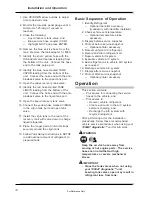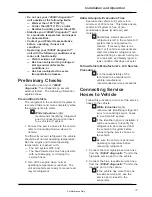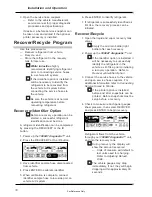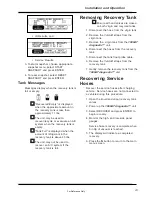
17
Installation and Operation
• Do not use your
1090AT diagnostic™
unit outside of the following limits:
— Warmer than 120°F (49°C),
— Colder than 50°F (10°C), and/or
— Relative humidity greater than 80%.
• Stabilize your
1090AT diagnostic™ unit
to a moderate temperature and inspect
for abnormalities.
• Contact your
White® representative
before operating if unsure of
condition.
• Operating your
1090AT diagnostic™
unit with the following conditions may
reduce its functionality:
— Visible evidence of damage,
— Has been subjected to prolonged
storage under unfavorable
conditions, or
— Has been subjected to severe
transportation stresses.
Preliminary Checks
Successful use of your
1090AT
diagnostic™ unit depends on several
external factors. The following information
explains these.
Precondition Vehicle
The refrigerant in the vehicle A/C system is
recovered faster and more completely when
the components are warm.
✓
✓
✓
✓
White Industries highly
recommends identifying refrigerant
prior to connecting service hoses
to a vehicle A/C system.
1. Connect the service hoses to the vehicle,
refer to
Connecting Service Hoses to
Vehicle.
To efficiently recover refrigerant, the vehicle
should be at normal operating temperature.
Run the engine until normal operating
temperature is reached, with:
— The A/C system OFF, and
— The hood lowered as much as possible
with out damaging or crimping the
service hoses.
2. Turn off the engine when normal
operating temperature is reached. The
unit and vehicle are ready to recover and
recycle refrigerant.
Allow Adequate Evacuation Time
Evacuate the vehicle A/C system for a
minimum of 30 minutes. This helps ensure
vehicle A/C system is free of non-
condensable gases (mostly air) and
moisture.
✓
✓
✓
✓
Sometimes a small amount of
refrigerant is left in the vehicle A/C
system that is not practical to
recover. If recovery time is too
short or if vehicle components are
cold, this parasitic refrigerant can
expand during a vacuum hold cycle
or a leak test, and falsely report a
leak condition that does not exist.
Follow Vehicle Manufacturer’s A/C Service
Procedures
✓
✓
✓
✓
It is the responsibility of the
technician to be familiar with
vehicle manufacturer
recommended service procedures.
Connecting Service
Hoses to Vehicle
Follow this procedure to connect the service
hoses to the vehicle.
✓
✓
✓
✓
White Industries highly
recommends identifying refrigerant
prior to connecting service hoses
to a vehicle A/C system.
✓
✓
✓
✓
If the identifier option is installed, it
will be necessary to identify the
refrigerant to be recovered from
the vehicle A/C system before
connecting the service hoses to
the vehicle.
✓
✓
✓
✓
Be sure the vehicle is at normal
operating temperature before
recovering refrigerant.
1. Connect the red, high-side service hose
from the
1090AT diagnostic™ unit to the
high-side service port on the vehicle.
2. Connect the blue, low-side service hose
from the
1090AT diagnostic™ unit to the
low-side port on the vehicle.
✓
✓
✓
✓
If the vehicle has more than one
low-side service port, use the
service port closest to the
evaporator.
For Reference Only




























